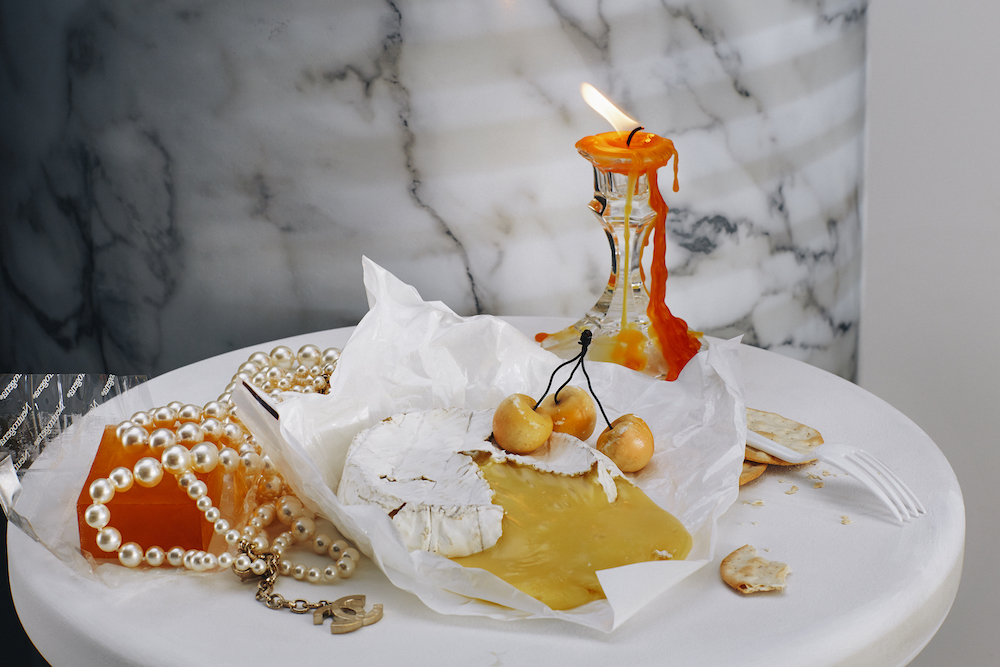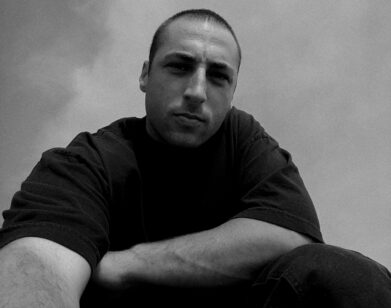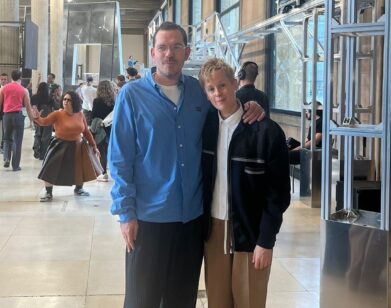Roe Ethridge’s Temporalities
A grid of images depicting a young girl and boy climbing sand dunes in a foggy Fort Tilden, New York are the first to appear in Neighbors, the catalog accompanying Roe Ethridge’s current mid-career retrospective “Nearest Neighbors” at the Contemporary Arts Center in Cincinnati, Ohio. While the catalog and exhibition—presented as part of this year’s FotoFocus Biennial—cover over 15 years of the Miami-born, New York-based photographer’s work, the choice to lead with these quiet photographs is telling.
The images, presented as one work titled Ft. Tilden: 03.14.15, are personal, shot in March 2015, and follow Ethridge’s two young children through a sparse landscape. They’re seemingly a departure for those familiar with Ethridge’s poppy commercial and editorial images, but they’re actually evidence of Ethridge’s consistent photographic mode: No matter the subject, he plays with temporality, incorporating cataloging, repetition, and layers. Often, there’s slight discomfort, suggesting something is out of alignment. For example, a glossy still life displaying a Chanel necklace also features melted cheese on a messy tabletop (Chanel Necklace for Gentlewoman, 2014); a crab appears upside-down, a specimen captured by a small hand and made still (Auggie with Dead Crab, 2015); other images show beautiful models, eating grapes or simply sitting at a dining room table—their glazed over eyes aren’t looking at the camera, in fact, they don’t seem to be looking at anything at all.
What’s most striking about all of these works is the feeling of familiarity they induce. They’re something seen before—perhaps on billboards, in old clothing catalogs, or in one’s own family archives—beckoning hazy, indistinct memories. In their layers, they speak to commercial image culture, and create subtle, disconcerting fantasies within grasp.
TESS MAYER: How do you connect the three series in the exhibition catalog: Ft. Tilden: 03.14.15, “Nearest Neighbor,” and “Sanctuary”? And why under the title Neighbors?
ROE ETHRIDGE: I think the title Neighbors is coming off the impulse to have that variation off the show title, but I also wanted to have a book that was doing something on it’s own—it wasn’t just the final word. I think my first instinct was I didn’t want to make a catalog for the show that was saying, “This is what I’ve done to this point.” … While it is a mid-career retrospective it’s very much a curated, thematically overlapping show; it isn’t a hundred works that define my life up to now. [laughs]
MAYER: Could you explain the Fort Tilden work?
ETHRIDGE: Over the years I’ve done work with family . It’s been one of the themes that runs through the work—for example, in the Shelter Island book [from 2016]. That Fort Tilden story [is a] long photo essay that I think of as one piece. It’s addressing something that I guess you can get to with a video. You have a sense of the temporal. I think Shelter Island does that. It’s this limited amount of time. The Fort Tilden pictures are taken all as one piece—it felt like it was another version of that temporality. It’s one of those things where I took the pictures without thinking of it too much, not like, “This is going to be the intro to my retrospective.” [laughs] But [it’s] something that I came back to, because there were so many haunting and mood and tone images that I really liked. So looking back through it felt like this whole thing is a piece—this whole chunk of time is the piece. In part, because it has this kind of twisted post apocalyptic [feeling].
MAYER: Yeah, most of them read that way, like post-apocalyptic children running through a forest. There’s these three in a sequence, and your son is completely trolling you and making a face in one, and I like how that takes you out of it just for a second. And then it goes into all these more landscape photos and ends with the graffiti on the sidewalk.
ETHRIDGE: Right. In some of the landscape and fence pictures we were passing the camera around, so they took some and I took some of those. That was maybe like a message in a bottle to them. In the future when they look back at it they’ll go, “Oh my god, that’s right, I took that picture.”
MAYER: To talk about your more commercial work, do you shoot these outtake like moments intentionally, or do you find these photos when you’re going through them afterwards?
ETHRIDGE: It’s almost always afterwards. The pictures of Tersea Oman [Double Teresa Oman, 2015] and Jess Gold [Double Jess Gold, 2015] in the bathing suits running—those were initially shot as single frames. It was only later that I started doing those overlapped images. That’s a case where I shot it being like, “This could be in the show,” and then it developed into this montage effect. Occasionally it does happen that while taking a picture on set I’m thinking, “Oh, that could be great,” but almost never. It’s very rare.
MAYER: Your shoots make it look like it’s so much fun to be on set. I’m thinking specifically of the Dazed shoot titled “The New Aesthetic.” Do you approach them as collaborations with the models?
ETHRIDGE: Yeah, I think so… It depends on the situation. In that case it was very much a fucked up beauty story. That required some courage on the part of the girls. It was asking a lot, like, “Can you look beautiful and have your mouth open with some kind of S&M thing? Or have Legos glued to your face?” Those jobs are always fun but isn’t always collaborative. Sometimes it doesn’t really allow for it.
MAYER: What photographers did you most admire while in college at the Atlanta College of Art?
ETHRIDGE: Oh gosh—I was in college for a long time. I’d say the things that felt like discoveries to me during that time [were] I was really into Lee Friedlander and Andy Warhol. It was these two different trajectories, but I liked them both. Going through college I was interested in appropriation ideas—that was the late ’80s. It took me seven or eight years to get a BFA. [laughs] At some point I discovered Thomas Ruff and the Bechers and German objective photography. That got my attention and it felt like it really incorporated into my aesthetic. While I don’t think my work would ever be mistaken for German objective photography, it was definitely a big influence at that time.
“NEAREST NEIGHBOR” IS ON VIEW AT THE CONTEMPORARY ARTS CENTER IN CINCINNATI, OHIO THROUGH MARCH 12, 2017. THE FOTOFOCUS BIENNIAL 2016 CONTINUES THROUGH OCTOBER 31, 2016.







